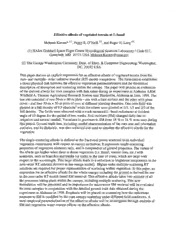
NASA Technical Reports Server (NTRS) 20110023341: Effective Albedo of Vegetated Terrain at L-Band PDF
Preview NASA Technical Reports Server (NTRS) 20110023341: Effective Albedo of Vegetated Terrain at L-Band
Effective albedo of vegetated terrain at L-band Mehmet Kurum* Peggy E. O'Neill (lJ, and Roger H. Lang (1), (2) (1) NASA Goddard Space Flight Center Hydrological Sciences Laboratory 1 Code 617, Greenbelt, MD 20771 USA [email protected] (2) The George Washington University, Dept. of Elect. & Computer Engineering, Washington, DC, 20052 USA This paper derives an explicit expression for an effective albedo of vegetated terrain from the zero- and multiple- order radiative transfer (RT) model comparison. The formulation establishes a direct physical link between the effective vegetation parameterization and the theoretical description of absorption and scattering within the canopy. The paper will present an evaluation of the derived albedo for com canopies with data taken during an experiment at Alabama A&M Winfield A. Thomas Agricultural Research Station near Huntsville, Alabama in June, 1998. The test site consisted of two 50-m x 60-m plots - one with a bare surface and the other with grass cover - and four 30-m x 50-m plots of com at different planting densities. One com field was planted at a full density of 9.5 plants/m2 while the others were planted at 1/3, 1/2 and 2/3 of the full density. The fields were observed with a truck-mounted L- band radiometer at incident angle of 15 degree for the period of two weeks. Soil moisture (SM) changed daily due to irrigation and natural rainfall. Variations in gravimetric SM from 18 % to 34 % were seen during this period. Ground truth data, including careful characterization of the com size and orientation statistics, and its dielectric, was also collected and used to simulate the effective albedo for the vegetation. The single-scattering albedo is defined as the fractional power scattered from individual vegetation constituents with respect to canopy extinction. It represents single-scattering properties of vegetation elements only, and is independent of ground properties. The values of the albedo get higher when there is dense vegetation (i.e. forest, mature corn, etc.) with scatterers, such as branches and trunks (or stalks in the case of com), which are large with respect to the wavelength. This large albedo leads to a reduction in brightness temperature in the zero-order RT solution (known as tau-omega model). Higher-order multiple-scattering RT solutions are required for proper representation of scattering within vegetation. In this paper, an expression for an effective albedo for the whole canopy including the ground is derived for use in the zero-order RT model-based SM retrieval. This effective albedo takes into account of all the processes taking place within the canopy, including multiple-scattering. This new formulation will be presented and its importance for microwave SM retrieval will be evaluated for com canopies in conjunction with the detailed ground truth data obtained during the experiment at Alabama in 1998. Emphasis will be placed on examining how the radiometer response to SM is modified by the corn canopy scattering under different field conditions. A semi-empirical parameterization of the effective albedo will be investigated through analysis of SM and vegetation water content effects on the effective albedo.
